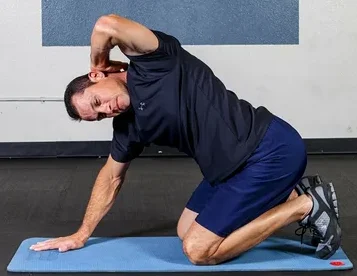Table of Contents
ToggleIntroduction
Flexibility is an integral component of overall fitness. It enhances your ability to perform aerobic and strength-training exercises, aids in injury prevention, and supports your everyday functional movements. Irrespective of your fitness level, incorporating flexibility exercises into your routine can significantly improve your health and well-being. This article will provide a comprehensive overview of the best flexibility exercises tailored to various fitness levels, from beginners to advanced athletes. Whether you’re just starting or looking to level up your workout regimen, you’ll find strategies here to boost your flexibility and elevate your fitness game.

Understanding Flexibility
Before diving into the specific exercises, it’s essential to understand what flexibility is and why it’s crucial for overall fitness. Flexibility refers to the range of motion (ROM) a joint can move freely without restriction or discomfort. It’s affected by factors such as age, genetics, and physical activity level.
Types of Flexibility
Flexibility comes in two forms: static and dynamic.
Static flexibility refers to the ability to stretch a muscle to its full extent and hold that position, often used in yoga and pilates. It’s a measure of the absolute range of motion in a joint or series of joints. On the other hand, dynamic flexibility, also known as kinetic flexibility, is the ability to perform dynamic movements within the full range of a joint. It involves moving parts of your body and gradually increasing reach, speed of movement, or both. Both types are crucial for overall fitness, with static flexibility enhancing deep muscle stretch and relaxation, and dynamic flexibility promoting better motion, reducing the risk of injury during sports or any physical activity.
Factors Influencing Flexibility
A variety of factors play into how flexible you are. Age is a key factor where, as you grow older, your muscles tend to lose elasticity, thus reducing flexibility. Genetics also plays a role, as some people naturally have more flexible joints than others. Lastly, activity level directly impacts flexibility, where those who regularly engage in physical activities, especially ones that involve stretching, tend to be more flexible. It’s important to remember that while we can’t control factors like age and genetics, we do have control over our activity levels and can work towards improving flexibility by incorporating regular stretching and strength exercises into our routines.
Assessing Your Flexibility Level
Before you start any flexibility exercises, it’s important to evaluate your current flexibility level. There are simple self-assessment techniques that you can use.
Self-Assessment Techniques
Sit and Reach Test: This is a common test for flexibility. Sit on the floor with your legs extended in front of you. Keep your knees straight and reach forward to touch your toes. If you can touch your toes with ease, you have good hamstring and lower back flexibility. If you can’t, then these are areas you should work on.
Shoulder Flexibility Test: Extend one arm above your head and bend at the elbow to reach toward the middle of your back. On the other hand, reach up from the lower back. The closer your hands can come to touching, the better your shoulder and upper back flexibility.
Trunk Rotation Test: Stand with your feet shoulder-width apart and your arms extended out to the sides. Twist your torso to the right and then to the left, keeping your feet firmly planted. The degree to which you can rotate your torso indicates your spinal flexibility.
Understanding Results
Understanding your test results is crucial in determining which exercises are best for you. If you found the sit and reach test difficult, it may indicate that you need to focus on exercises that improve the flexibility of your lower back and hamstrings. If your hands don’t come close in the shoulder flexibility test, exercises that enhance shoulder and upper back flexibility would be beneficial. And if you can only rotate your torso a small amount in the trunk rotation test, exercises that increase spinal flexibility should be part of your routine.
Flexibility Exercises for Beginners
Introduction to Stretching
Stretching is a practice that involves gently elongating muscles, tendons, and other soft tissues, helping to increase the range of motion at your joints, improve blood flow, and prepare your body for physical exertion. It’s a fundamental component of any fitness program, serving to enhance performance, reduce the risk of injury, promote recovery, and improve posture and alignment.
Basic Stretches
To start, several simple stretches target major muscle groups:
Neck Stretch: Tilt your head towards one shoulder, holding for 15–30 seconds. Repeat on the other side.
Shoulder Stretch: Extend one arm across your body, using your other arm to hold it in place and deepen the stretch. Hold for 15–30 seconds and switch sides.
Wrist Stretch: Extend one arm in front of your body, palm facing upwards. Use your other hand to gently pull your fingers back towards you. Repeat on the other side.
Hamstring Stretch: Sit on the ground with one leg extended, and the other bent with your foot touching the inner thigh of your extended leg. Lean forward from your hips, reaching towards your extended foot. Hold for 15–30 seconds and switch sides.
Quadricep Stretch: Stand and hold onto something for balance. Grab your right foot with your right hand and pull it towards your buttocks, keeping your knees close together. Hold for 30 seconds and repeat with the other leg.
Guidelines for Beginners
As a beginner, aim to stretch all major muscle groups at least two to three times per week after your workouts when your muscles are warmed up and receptive to stretching. Each stretch should be held for 15–30 seconds and repeated 2–3 times. Proper form is crucial — keep your movements smooth and controlled, avoid bouncing, and always stretch both sides of your body equally. Remember to breathe normally throughout your stretches, never hold your breath. As your flexibility improves, you can gradually increase the duration and frequency of your stretching sessions.
Advanced Flexibility Training
Once you have mastered the basics of flexibility training and have seen noticeable improvement in your range of motion, it’s time to progress to advanced stretching techniques. These exercises are particularly beneficial for athletes, dancers, or fitness enthusiasts looking to further increase their flexibility and performance.

Active Stretching: Unlike static stretches, active stretching depends on the strength of your opposing muscles to hold a stretch. An example is lifting a leg and holding it in position without the support of your hands.
PNF Stretching: Proprioceptive Neuromuscular Facilitation (PNF) is a more advanced form of flexibility training that involves both the stretching and contraction of the muscle group being targeted. It is one of the most effective forms for increasing static-passive flexibility.
Flow Stretching: This involves moving parts of your body and gradually increasing reach, speed of movement, or both. It is an excellent way to warm up the body and enhance dynamic flexibility.
FAQs
How often should I perform flexibility exercises?
As a beginner, aim to stretch all major muscle groups at least two to three times per week. As your flexibility improves, you can gradually increase the duration and frequency of your stretching sessions.
What should I focus on when stretching?
Proper form is crucial. Keep your movements smooth and controlled, avoid bouncing, and always stretch both sides of your body equally. Remember to breathe normally throughout your stretches, never hold your breath.
What time of the day should I stretch?
Ideally, stretching is best done after your workouts when your muscles are warmed up and receptive to stretching. However, you can also dedicate separate sessions to flexibility training if you prefer.
Conclusion
In conclusion, flexibility exercises form an essential cornerstone of any fitness regimen, delivering a host of benefits that include improved range of motion, injury prevention, enhanced performance, and better posture. Starting with basic stretches and gradually progressing to more advanced techniques such as active, PNF, and flow stretching, you can significantly improve your overall flexibility, regardless of your current fitness level. Remember, consistency is key, and it’s important to maintain proper form and control during your stretches. With time, patience, and regular practice, you’ll witness noticeable improvements in your flexibility and overall fitness.




















